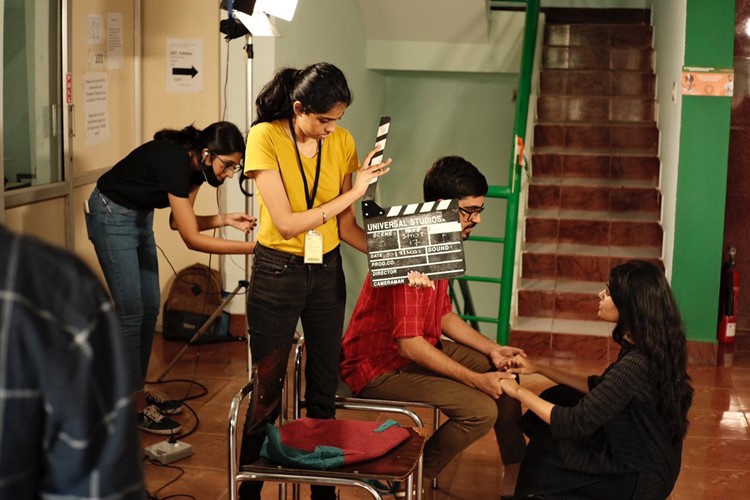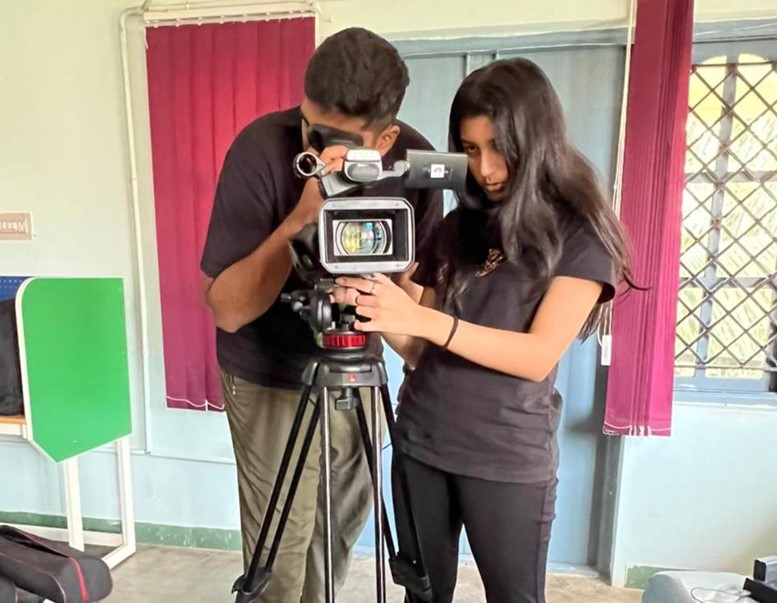“Film is the greatest teacher, because it teaches not only through the brain, but through the whole body”
- Vsevolod Pudovkin

Focused Area Study - Shoot
Vision
In the India of today, manifestations of the media are both varied and numerous. The growth rates of the Film and Television sectors are escalating at a rapid pace providing an ideal opportunity for employment.
This course aims to initiate learners into an engaging media culture that addresses the needs of the present-day media scenario. The program aspires to provide the media and entertainment industry with technically competent professionals specialized in various areas of filmmaking. It also equips the student to adapt and grow in a world which is constantly changing.
Sector
The three years of this program align with the Levels 4, 5, 6 and 7 of NSQF guidelines and creates skilled employees for the Media and Entertainment sector.
Overview
The Digital Filmmaking course lays an emphasis on practical skill building on multi-leveled technology platforms augmented with theoretical sessions through a variety of teaching approaches. An understanding of the context of the moving image and sound creates a framework within which skill, technology and aesthetics are situated.
Apart from disciplinary exercises, semester ending projects and Capstone project, students are offered spaces for interdisciplinary engagement. The course is unique in that it works closely with media production units in the field exposing students constantly to real world learning and understanding.

Fundamentals of Film
Course Structure
The core principles that govern the design of the unit are as follows:
Mastery Learning with Guided Practice breaks down competences or skills into subskills, methods and techniques. Through targets taught through modelling and direct instruction followed by guided and independent practice, mastery of core competences and skills are achieved.
Work Related Learning is the co-design of opportunities/projects by industry based professionals or employers or other stakeholders on the one hand and faculty on the other. Guided and facilitated by mentors this space allows for future employers to participate in the learner’s journey.
Industry Linkages include both exposure, orientation and direct interactive learning in real time contexts. This is towards specific jobs and roles, as well as work experience within each course’s respective industrial sector. Linkages between academic institutions and creative industries is inclusive of both economic and social benefits of innovation.
Fab. Ateliers build on the values of thinking, modelling and making to challenging design contexts drawn from indigenous knowledge and / or tools from digital technology.
Public Labs are open spaces that foster DIY thinking along with citizen science and other initiatives to build a culture of learning that is self-initiated, independent and collaborative. Public Labs are open to all learners for purposes of self-study, learning, archiving and developing personal interests in technologies.
Bootcamps foster accelerated learning of concepts, skills and technologies that are directly linked to either employable, entrepreneurial or livelihood based skills. Working through immersion, with a focus on hands-on problem solving and peer learning rather than instruction.
Hackathons can range from competitions or events over days to half-day jams or a one day hack-fest. This format encourages brainstorming, pitching of concepts, working in teams and also planning projects as well as development of prototypes.
Pathways
Digital Filmmaking offers a choice of two pathways. After one year of study, students can choose any one pathway.
People
Enquiries

FAQs
Today most filmmaking has moved from the celluloid to the digital. While many principles and concepts remain the same, a lot has changed in terms of handling digital material both technically and aesthetically. This in turn has also affected the work flow, costing and the distribution of a project.
Today the very notion of cinema has changed. Cinema no longer connotes the traditional classical proscenium mode – no doubt that form still exists. But if you reflect on how you watch moving image content, it is apparent that it is through multiple ways – in the theatre, on the streets, television, laptops, smartphones, tablets or even your watch. Media has become an extension of ourselves. There is a great need for skilled technical professionals to produce video and audio content for these multiple spaces. This existing gap on one side and the rapidly increasing projected growth rates in this sector on the other, presents you an ideal career opportunity.
If you like to tell stories, create a narrative and find a visual design for your story, then this course will engage you. If you would like to design a space to situate a story or are inquisitive to find a relationship between sound and image, then this could be a choice you should consider.
Please download the prospectus on the course page to know about the learning units that will be taught in this course.
Since film is a collaborative art form it becomes integral to understand the roles and inter-relationships between different domains within the film production process. Wherever one chooses to position oneself it is in relation to the other departments and it becomes imperative that one shares and understands a common vocabulary – this in essence is the first year of the program where one is immersed into a holistic understanding of filmmaking.
Students follow a pathway for the remaining two years of their program. While each pathway has specific learning outcomes and specialised competence building, all the pathways aim to create professionals who are reflective and critical about their practice.
The ‘Direction and Editing’ pathway aims to create technically competent directors by understanding the role of the director in different genres of filmmaking. This pathway also offers students a second skill - ‘Editing’ that will give them an added advantage in the industry.
The ‘Cinematography’ pathway aims to create technically capable cinematographers through a hands-on practice in a variety of digital formats, contextualized by understanding visual culture. This pathway is constructed around understanding cinematographic practice and workflow in the new environment of digital image making.
All pathways require specialized training and competence building and therefore these are offered as two separate areas of learning. From the second year - you are required to choose your area of interest in either one of these two pathways. While there are some learning units that are common across the pathways, you are not encouraged to change your pathway once chosen. All learning units for each of the pathways are defined and mandated.
The Digital Filmmaking course trains students so that they have added opportunities for employment at various levels across the spectrum of this creative industry. Based on your disposition and focus area you will have a choice to enter various sectors within the industry, such as feature films, television, documentary, web based content, advertisement or social communication. You will enter the film and television industry as quality technical film artists specialized in a specific area of filmmaking and will be able to collaborate across media- film, gaming, immersive media and animation.
This course will also open avenues for higher education in art, technology and design.



